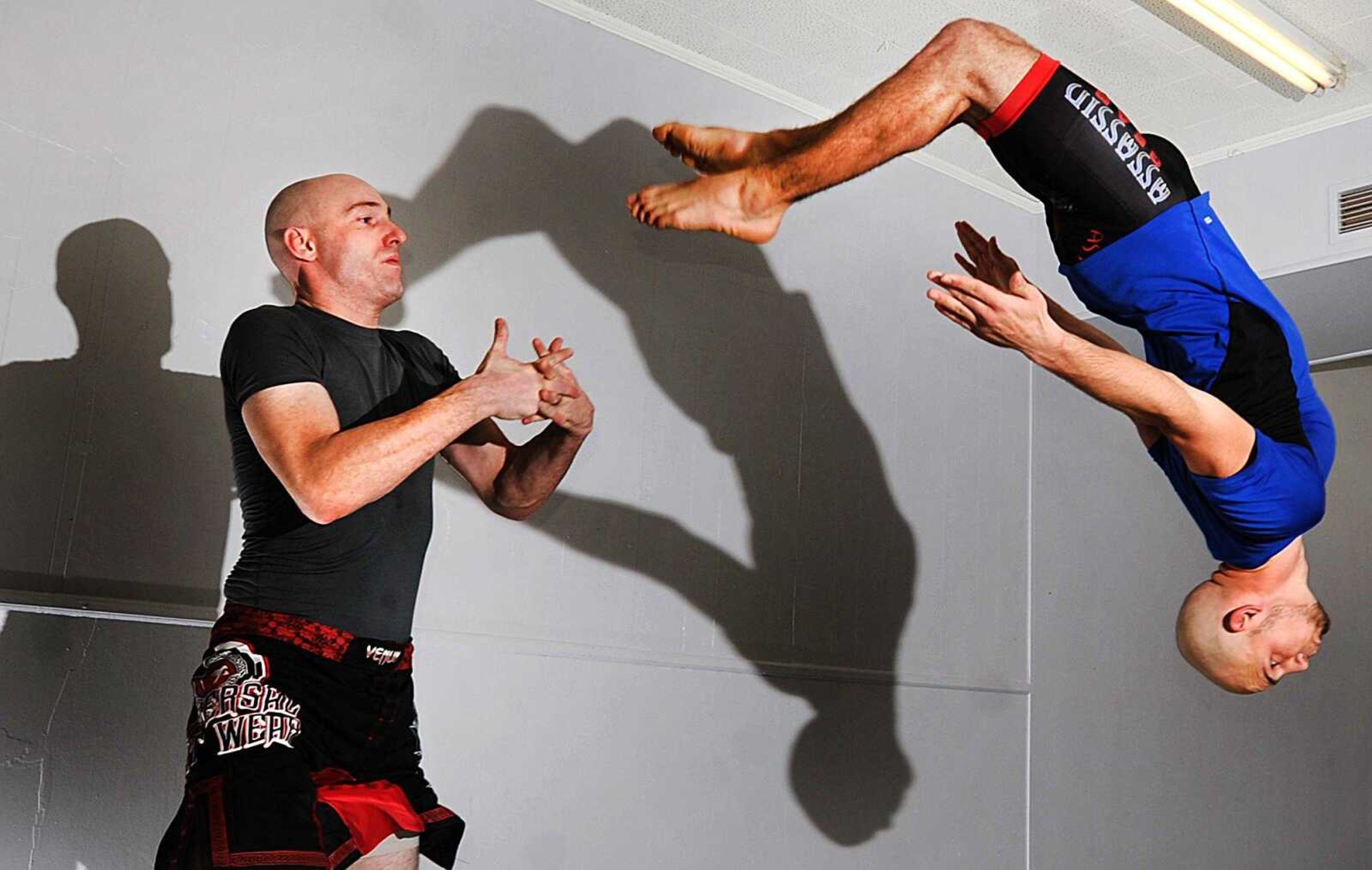Greek-fighting men
Josh Caputo and Jake Culver give the term "history buff" new meaning. Caputo's Spartan Academy in Cape Girardeau teaches a number of martial arts techniques, but they're all rooted in an ancient fighting discipline called pankration. By 8 on a Tuesday evening, the windows are already fogged from body heat as inside fighters spar and grapple loosely in preparation for the night's workout...
Josh Caputo and Jake Culver give the term "history buff" new meaning.
Caputo's Spartan Academy in Cape Girardeau teaches a number of martial arts techniques, but they're all rooted in an ancient fighting discipline called pankration.
By 8 on a Tuesday evening, the windows are already fogged from body heat as inside fighters spar and grapple loosely in preparation for the night's workout.
"Spartans! On the line!" Culver barks. "On the line. Let's go!"
He joins the fighters in high-knee jogging, long jumps and other assorted calisthenics to get the blood pumping as Caputo explains why they've been drawn to pankration.

"It's conquered the world three separate times," he says, referring to the armies of Agamemnon, Alexander the Great and ancient Rome, all of whose soldiers were proficient in the fighting style. The fighters gathered on this occasion aren't training to conquer Babylon -- they're training to conquer the discipline.
"[Mixed martial arts] is really not a new concept," he says. "Despite all the pop culture that surrounds it, it really dates back to before Christ."
He explains that, while most combat disciplines are predicated on certain restrictions -- thou shalt not hit below the belt in boxing -- pankration is unique for its lack of off-limits moves.
"It was one of the original Olympic sports," Caputo says. "And back then, everything but biting and eye-gouging was fair game. That includes shots to the groin, small-joint manipulation, lots of things."
For classes such as Tuesday's, however, Caputo and Culver focus on more orthodox skills. The kinds of things an MMA fighter would actually be able to use.

Both became interested in pankration after running across it in history.
"It's the root foundation of all martial arts," Caputo says. "The name in Greek actually means 'all-powers' or 'all-skills.'"
But it's one of the more obscure disciplines. It's lesser-known than muay thai or jujitsu, to say nothing of the MMA advertising juggernaut.
It took Caputo five years of email correspondence before he was able to persuade pankration master Aris Makris to visit and teach him and Culver how to be instructors.
"Jake, when was Aris here?" Caputo asks.

"June," he answers, mid-jog, prying out his mouth guard. "The sixth through the ninth."
Evidently, those four days were pretty significant for Caputo and Culver.
"That 52-year-old man with a bad back kicked my rear end with little effort," Culver explains, stepping out of warm-ups. Standing well over six feet tall, Culver isn't threatened by many 52-year-olds, but Makris, he explained, is legendary.
"He's a two-time martial arts hall of fame inductee. Blindingly fast and brutally effective."
Makris now lives in Canada, teaching high-level pankration certification seminars, and, Culver points out, Caputo's Spartan Academy is the only Makris-sanctioned facility in Missouri.
"OK, let's make this a little more kinetic, shall we?" Caputo tells the class, strapping on a pair of boxing pads. As he runs them through a dodge-and-counterattack drill, Culver points out the main difference between pankration and MMA.
"I've been a part of several MMA teams over the years, and what I've noticed is that in pankration, there's no hesitation between positions," he says. "An MMA-trained fighter, maybe they go against the cage during a fight. There's a hesitation before they throw a knee or whatever. In pankration, you learn how to respond without that hesitation."
The bottom line in pankration is to subdue an opponent as expeditiously as possible, Culver explains over the flat smacking of punch combinations.
It lends itself well to self-defense, which Culver and Caputo also teach. Culver takes the lead as Caputo explains the differences between sporting and combative pankration.
"You can learn jujitsu or something where you can subdue someone on the ground, but in the real world, there's broken glass in the alley. If someone pulls you down, you need to understand striking as well."
And in real-world self-defense, all bets are off, which means pankration's head-butting, finger-breaking and low blows become lifesaving techniques.
While there are already several women who train with them, Culver and his wife, Caitlin, are designing a course specifically for women's self-defense.
"Do not weave a hook, gentlemen!" Culver warns. "You will get hit. Simple as that."
"Yeah, it's a full-contact thing sometimes," Caputo says. "But what it comes down to is a superior, all-encompassing martial science discipline."
tgraef@semissourian.com
388-3627
Connect with the Southeast Missourian Newsroom:
For corrections to this story or other insights for the editor, click here. To submit a letter to the editor, click here. To learn about the Southeast Missourian’s AI Policy, click here.










